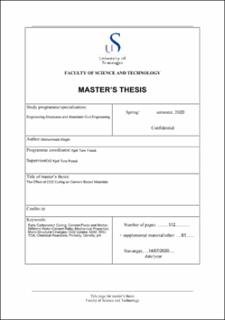| dc.description.abstract | Early carbonation curing of concrete elements has been shown to be a promising sustainable technology for CO2 capture and utilization, which would be beneficial for the environment. It has been found that carbonation curing would also improve the mechanical properties as well as permeability. In this study, the effect of early age carbonation curing on the mechanical, chemical and micro-structural properties of cement paste and mortar with two different water-cement ratio of 0.3 and 0.6 was examined. Five hours of initial controlled air curing in the climate chamber with RH of 60% and temperature of 25°C, prior to four and eight hours of carbonation curing with CO2 pressure and concentration of 6 bars and 99% , respectively, was carried out. This study confirms that, carbonation curing would mainly happen in the first two hours. Water-cement ratio is an important parameter for the process, w/c of 0.3 shows higher capacity of CO2 uptake. Besides, mortar elements, due to their porous nature, show higher potential for CO2 uptake, around 15% of cement weight, compare to 9% for cement paste, thermogravimetric’s results serve as supporting evidence. In terms of mechanical properties, the results show that, with proper mix design and pre-conditioning, carbonation curing would result in a high rapid 1-day compressive strength development rate up to 125% and 45% for mortar and cement paste specimens, respectively, in comparison with normal air curing specimens. Besides, carbonation curing results in higher strength, after 14 days, compare to the reference. Carbonation curing also results in reduction of both suction and macro porosity, it decreases the total porosity up to 10% and 7% for mortar and cement paste elements, respectively, which resulted in higher density for carbonation cured samples. In spite of the traditional belief regarding a reduction in pH level as a result of the carbonation procedure, the results show the pH level above 12 for all the carbonation cured samples. Micro-structural changes are evaluated by using multiple techniques. X-Ray Diffraction, Thermogravimetric Analysis and Scanning Electron Microscopy examinations indicate that the early carbonation curing results in rapid formation of CaCO3 crystals due to the reaction of CO2 with cement phases and hydration products itself to create a micro-structure with higher strength contributor than conventional hydration. The results also show less amount of CH and high amount of calcite in carbonation cured samples. | en_US |
